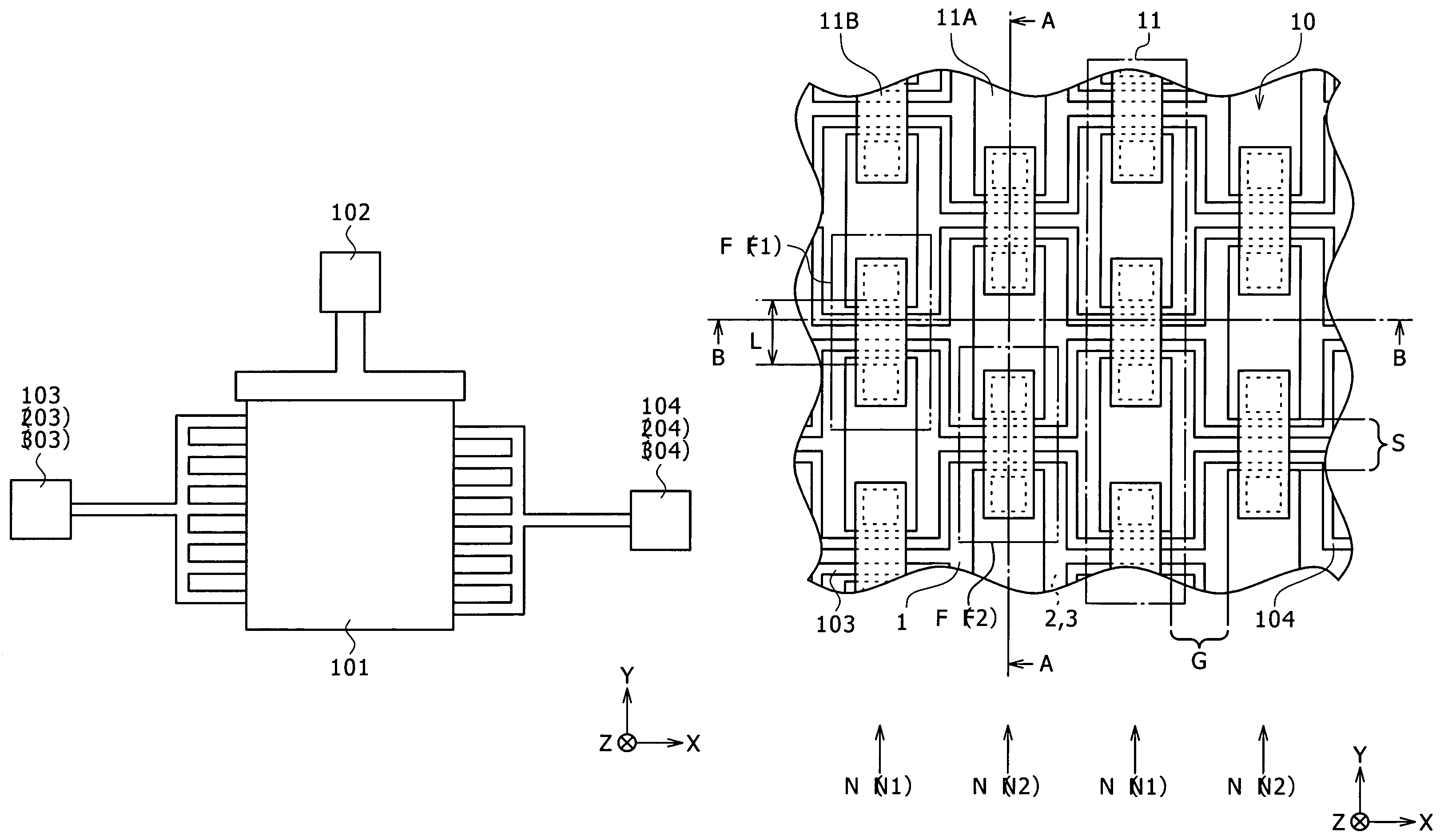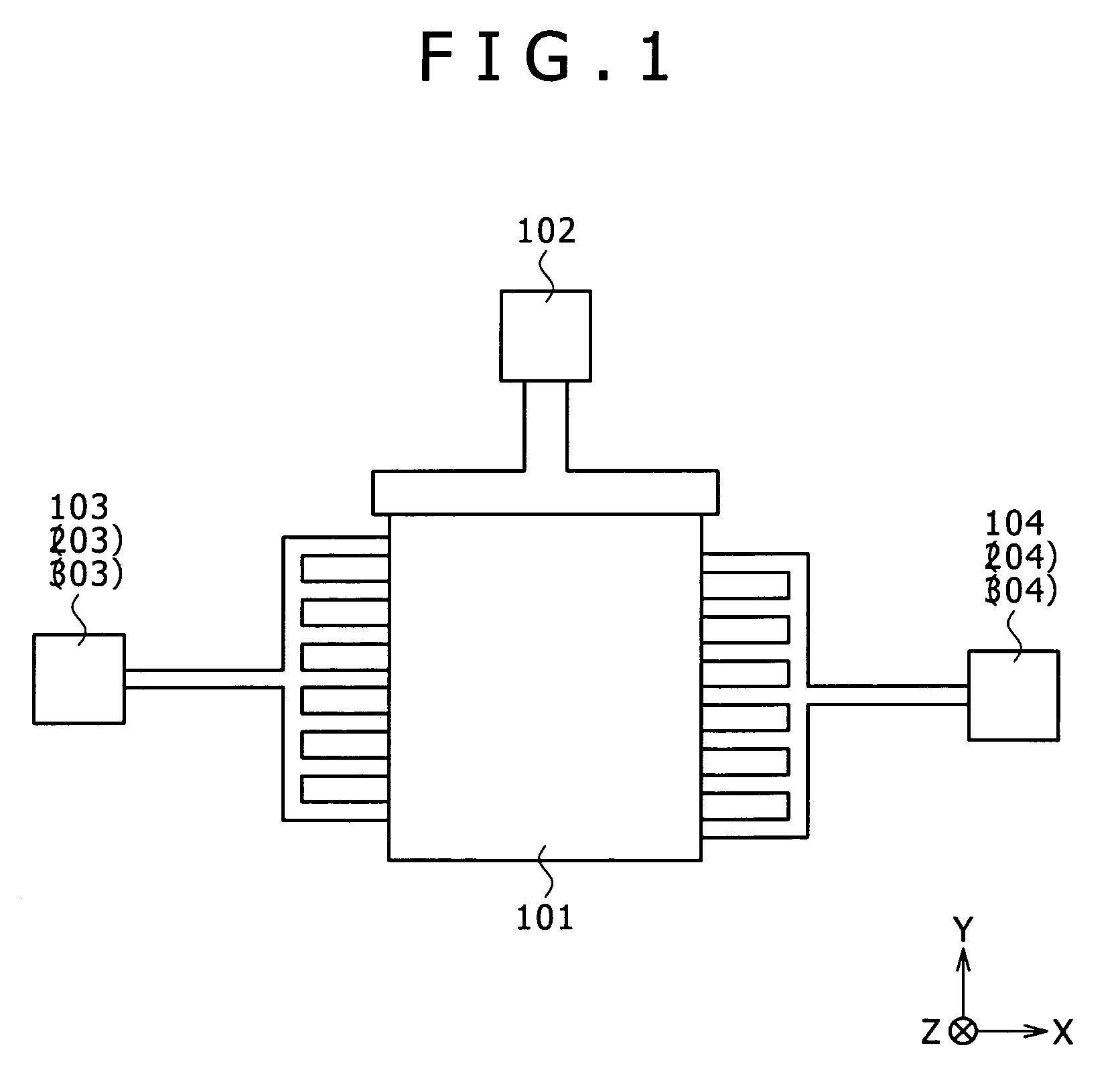Microresonator, manufacturing method, and electronic apparatus
a manufacturing method and micro-resonator technology, applied in waveguide devices, instruments, projectors, etc., can solve the problems of difficult to ensure a desired frequency characteristic and frequency characteristic deterioration, and achieve the effect of less susceptible to deterioration
- Summary
- Abstract
- Description
- Claims
- Application Information
AI Technical Summary
Benefits of technology
Problems solved by technology
Method used
Image
Examples
first embodiment
[0054]The structure of a microresonator according to a first embodiment of the invention will be described with reference to FIG. 1. FIG. 1 illustrates the planar structure (planar structure along the XY-plane) of the microresonator.
[0055]The microresonator according to the present embodiment is a microstructure (so-called micromachine) used for controlling frequencies for example. Specifically, the microresonator is applied, as a high-frequency filter having a mechanism for controlling frequencies, to an electronic apparatus typified by a communication device such as a cellular phone used in a wireless communication field. Referring to FIG. 1, the microresonator includes a resonant circuit 101 that is an essential part implementing resonant operation, and three electrodes provided for the resonant circuit 101: a DC applying electrode 102 for applying direct current voltages; an input electrode 103 for inputting signals; and an output electrode 104 for outputting signals. Both the i...
second embodiment
[0085]A second embodiment according to the invention will be described below.
[0086]Initially, the structure of a microresonator according to a second embodiment of the invention will be described with reference to FIGS. 15 to 17. FIGS. 15 to 17 illustrate the structure of the resonant circuit 101 shown in FIG. 1 in a magnified form. FIG. 15 illustrates the planar structure (planar structure along the XY-plane). FIG. 16 illustrates the sectional structure along the line A-A of FIG. 15 (sectional structure along the YZ-plane). FIG. 17 illustrates the sectional structure along the line B-B of FIG. 15 (sectional structure along the XZ-plane).
[0087]The microresonator according to the present embodiment has almost the same structure as that of the microresonator of the first embodiment (refer to FIGS. 1 to 4), except that the present embodiment includes a microresonator structure 20 instead of the microresonator structure 10, and the microresonator structure 20 includes an input electrode...
third embodiment
[0102]A third embodiment according to the invention will be described below.
[0103]Initially, the structure of a microresonator according to a third embodiment of the invention will be described with reference to FIGS. 24 to 26. FIGS. 24 to 26 illustrate the structure of the resonant circuit 101 shown in FIG. 1 in a magnified form. FIG. 24 illustrates the planar structure (planar structure along the XY-plane). FIG. 25 illustrates the sectional structure along the line A-A of FIG. 24 (sectional structure along the XZ-plane). FIG. 26 illustrates the sectional structure along the line B-B of FIG. 24 (sectional structure along the YZ-plane).
[0104]The microresonator according to the present embodiment has almost the same structure as that of the microresonator of the first embodiment (refer to FIGS. 1 to 4), except that the present embodiment includes a microresonator structure 30 instead of the microresonator structure 10, and the microresonator structure 30 includes an input electrode 3...
PUM
 Login to View More
Login to View More Abstract
Description
Claims
Application Information
 Login to View More
Login to View More - R&D
- Intellectual Property
- Life Sciences
- Materials
- Tech Scout
- Unparalleled Data Quality
- Higher Quality Content
- 60% Fewer Hallucinations
Browse by: Latest US Patents, China's latest patents, Technical Efficacy Thesaurus, Application Domain, Technology Topic, Popular Technical Reports.
© 2025 PatSnap. All rights reserved.Legal|Privacy policy|Modern Slavery Act Transparency Statement|Sitemap|About US| Contact US: help@patsnap.com



